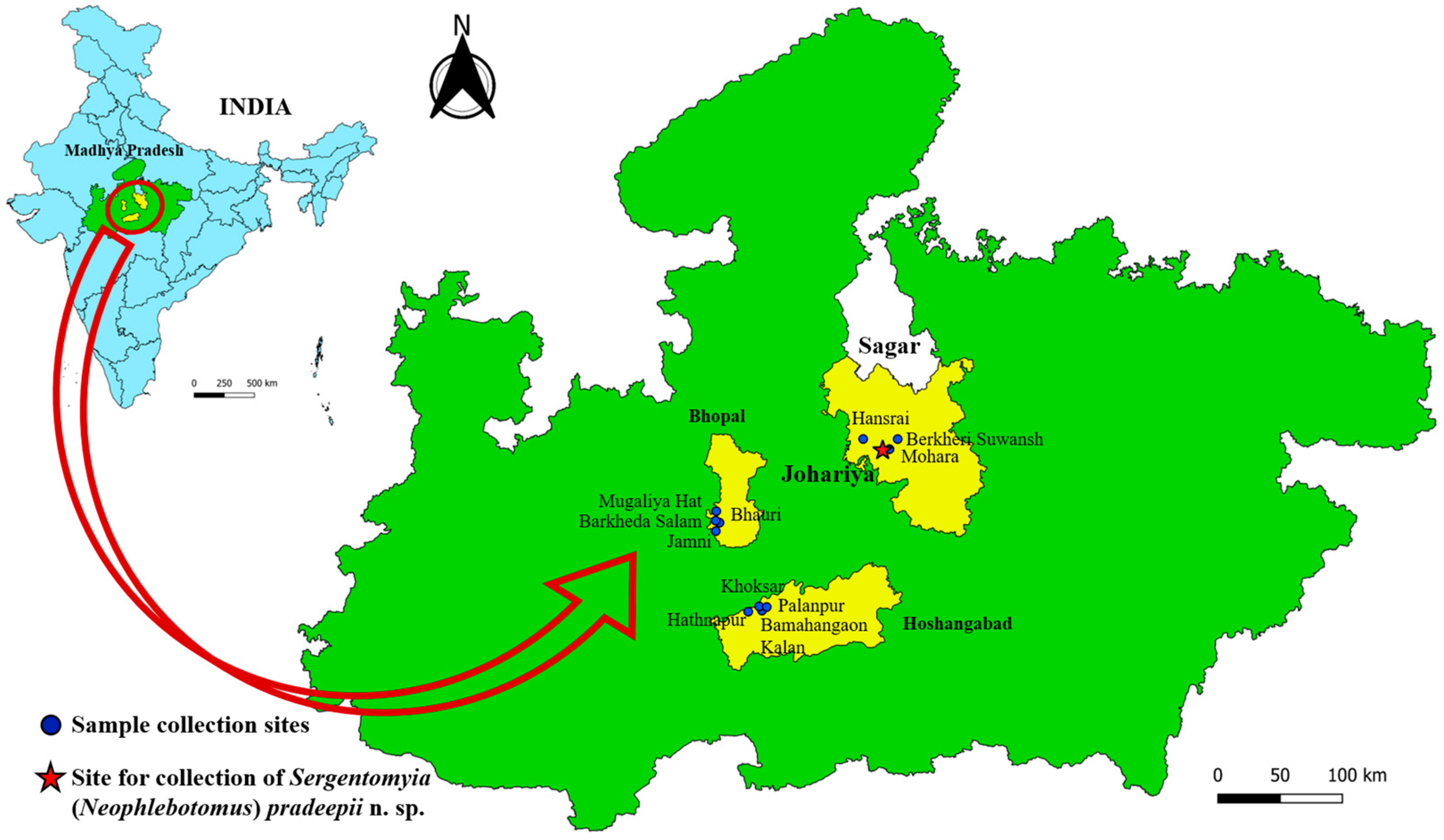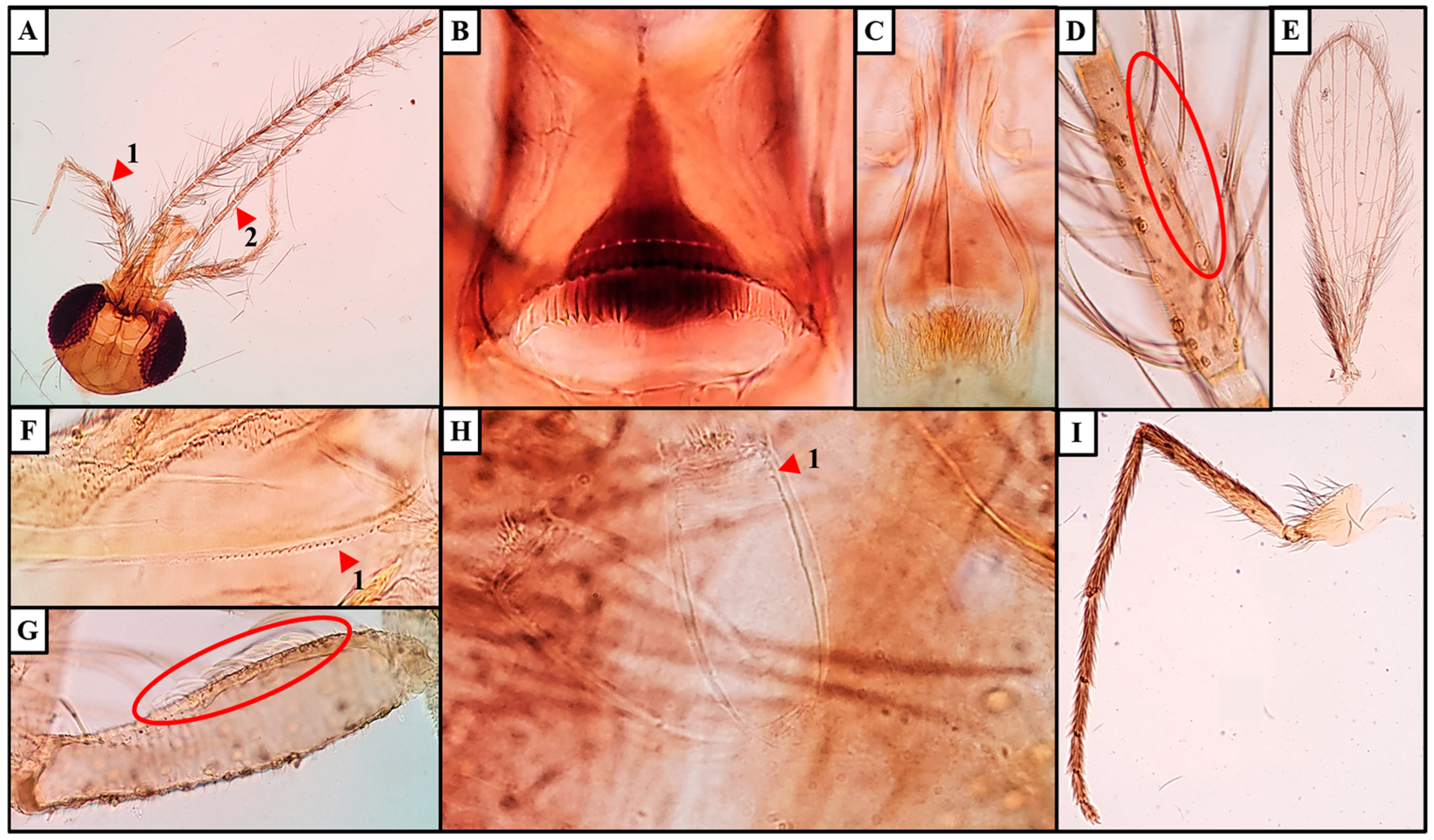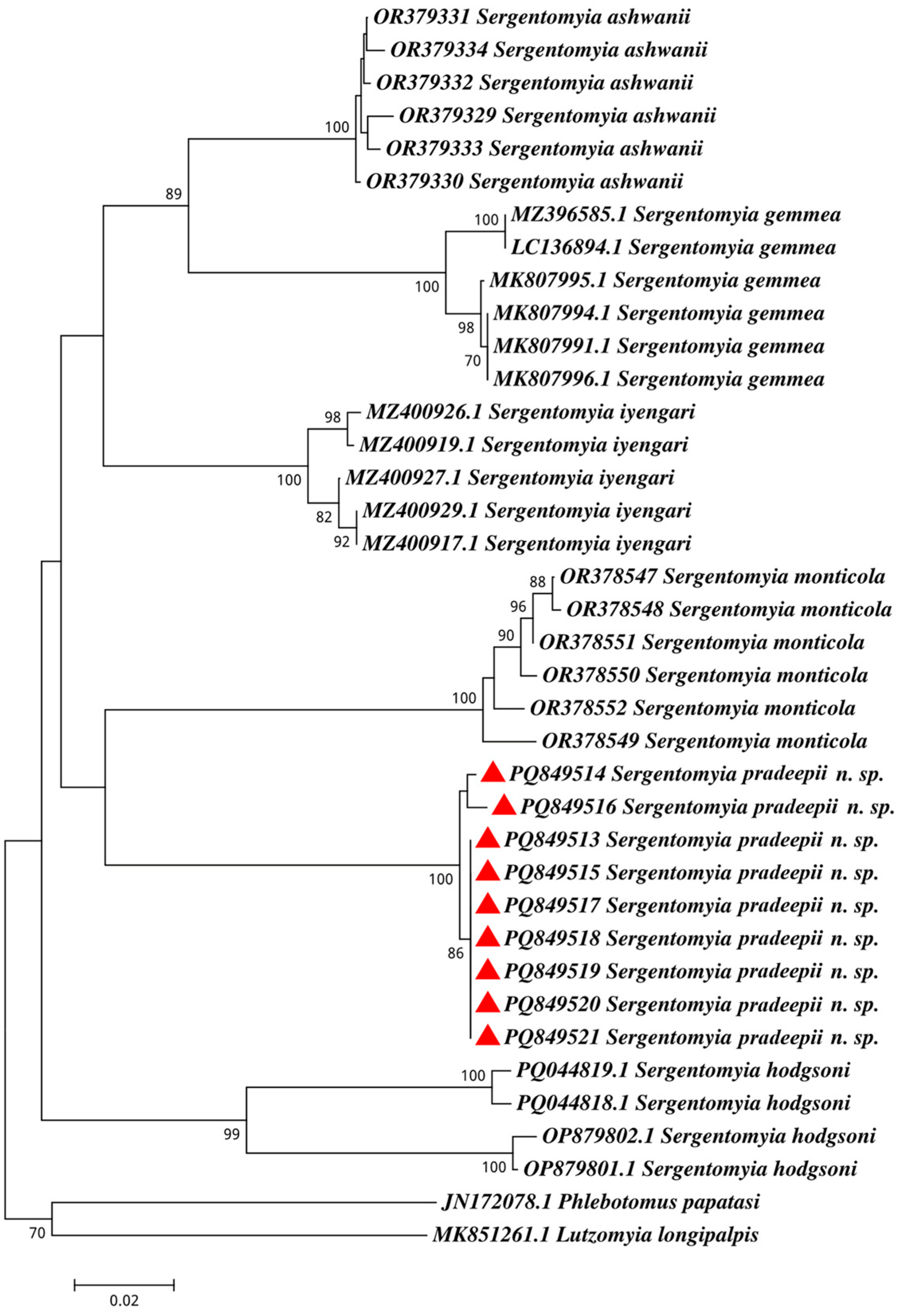Report of a New Sand Fly (Diptera: Psychodidae) Species, Sergentomyia (Neophlebotomus) pradeepii n. sp. from Madhya Pradesh, India
Simple Summary
Abstract
1. Introduction
2. Materials and Methods
2.1. Study Area
2.2. Morphological Identification of Sand Flies
2.3. Molecular Identification
2.4. Phylogenetic Analyses
3. Results
3.1. Female
3.2. Male
3.3. Diagnosis of Sergentomyia (Neophlebotomus) pradeepii n. sp.
3.4. Morphological and Molecular Variability
3.5. Type Locality and Materials
3.6. Etymology
3.7. ZooBank Registration
4. Discussion
5. Conclusions
Author Contributions
Funding
Data Availability Statement
Acknowledgments
Conflicts of Interest
Abbreviations
| COI | Cytochrome c oxidase subunit I |
| Neo. | Neophlebotomus |
| NTD | Neglected tropical disease |
| SCs | Scheduled Castes |
| STs | Scheduled Tribes |
| VL | Visceral leishmaniasis |
| PKDL | Post Kala-azar Dermal Leishmaniasis |
| ICZN | International Code of Zoological Nomenclature |
| gDNA | Genomic DNA |
| ZSI | Zoological Survey of India |
| NCBI | National Center for Biotechnology Information |
| ICMR | Indian Council of Medical Research |
| VCRC | Vector Control Research Centre |
| GD | Genetic distance |
References
- WHO. Leishmaniasis. Available online: https://www.who.int/news-room/fact-sheets/detail/leishmaniasis (accessed on 22 April 2025).
- Cecílio, P.; Cordeiro-da-Silva, A.; Oliveira, F. Sand Flies: Basic Information on the Vectors of Leishmaniasis and Their Interactions with Leishmania Parasites. Commun. Biol. 2022, 5, 305. [Google Scholar] [CrossRef] [PubMed]
- Galati, E.A.B.; Rodrigues, B.L. A Review of Historical Phlebotominae Taxonomy (Diptera: Psychodidae). Neotrop. Entomol. 2023, 52, 539–559. [Google Scholar] [CrossRef] [PubMed]
- Shah, H.K.; Fathima, P.A.; Kumar, N.P.; Kumar, A.; Saini, P. Faunal Richness and Checklist of Sandflies (Diptera: Psychodidae) in India. Asian Pac. J. Trop. Dis. 2023, 16, 193–203. [Google Scholar] [CrossRef]
- Saini, P.; Shah, H.K.; Jessu, M.; Sonia, T.; Anns, T.; Amju, K. Morphological and Molecular Description of a New Species of Sandfly, Sergentomyia (Neophlebotomus) ashwanii sp. nov. (Diptera: Psychodidae) from Western Ghats, India. Asian Pac. J. Trop. Dis. 2024, 17, 226–234. [Google Scholar] [CrossRef]
- Shah, H.K.; Fathima, P.A.; Jicksy, J.; Saini, P. Report of a New Species of Sand Fly, Phlebotomus (Anaphlebotomus) ajithii n. sp. (Diptera: Psychodidae), from Western Ghats, India. Parasit. Vectors 2024, 17, 388. [Google Scholar] [CrossRef] [PubMed]
- Government of Madhya Pradesh. State Profile. Available online: https://mp.gov.in/state-profile (accessed on 22 April 2025).
- Forest Survey of India. India State of Forest Report 2019; Forest Survey of India: Dehradun, India, 2019; pp. 1–11.
- Census. Madhya Pradesh Population, Sex Ratio & Literacy Rate. Available online: https://www.census2011.co.in/census/state/madhya+pradesh.html (accessed on 22 April 2025).
- Saini, P.; Fathima, P.A.; Aiswarya, R.S.; Ajithlal, P.M.; Rajesh, K.R.; Simi, S.M.; Pradeep Kumar, N.; Kumar, A. Cutaneous and Visceral Leishmaniasis Caused by the Same Zymodeme of Leishmania donovani in Kerala, India. Am. J. Trop. Med. Hyg. 2024, 110, 59–63. [Google Scholar] [CrossRef] [PubMed]
- Lata, S.; Kumari, S.; Das, R.; Pasi, S.; Dhiman, R.C. Typical and Atypical Cutaneous Leishmaniasis in Himachal Pradesh (India). Heliyon 2021, 7, e07282. [Google Scholar] [CrossRef] [PubMed]
- Nandedkar, S.; Malukani, K.; Varma, A. Maiden Visit of Visceral Leishmaniasis to Malwa Region. J. Commun. Dis. 2011, 43, 233–235. [Google Scholar] [PubMed]
- Shah, H.K.; Fathima, P.A.; Ajithlal, P.M.; Kumar, A.; Rawani, A.; Thakur, M.S.; Mohanty, S.S.; Sarma, D.K.; Pandey, K.; Kumar, A.; et al. Nationwide Cross-Sectional Surveillance of Leishmania donovani in Phlebotomine Sand Flies and Its Impact on National Kala-Azar Elimination in India. Sci. Rep. 2024, 14, 28455. [Google Scholar] [CrossRef] [PubMed]
- Alexander, B. Sampling Methods for Phlebotomine Sandflies. Medical Vet. Entomol. 2000, 14, 109–122. [Google Scholar] [CrossRef] [PubMed]
- Kalra, N.; Bang, Y. Manual on Entomology in Visceral Leishmaniasis; World Health Organization: New Delhi, India, 1988; pp. 1–88. [Google Scholar]
- Lewis, D. The Phlebotomine Sandflies (Diptera: Psychodidae) of the Oriental Region; Entomology; Bull Br Mus, Natural History: London, UK, 1978; Volume 37, pp. 217–343. [Google Scholar]
- Srinivasan, R.; Jambulingam, P.; Kumar, N.P. Sergentomyia (Neophlebotomus) monticola, a New Species of Sand Fly (Diptera: Psychodidae) from the Western Ghats, Thiruvananthapuram District, Kerala, India. Acta Trop. 2014, 137, 74–79. [Google Scholar] [CrossRef] [PubMed]
- Galati, E.A.B.; Galvis-Ovallos, F.; Lawyer, P.; Léger, N.; Depaquit, J. An Illustrated Guide for Characters and Terminology Used in Descriptions of Phlebotominae (Diptera, Psychodidae). Parasite 2017, 24, 1–35. [Google Scholar] [CrossRef] [PubMed]
- International Commission on Zoological Nomenclature. Amendment of Articles 8, 9, 10, 21 and 78 of the International Code of Zoological Nomenclature to Expand and Refine Methods of Publication. ZK 2012, 219, 1–10. [Google Scholar] [CrossRef] [PubMed]
- Kumar, N.P.; Srinivasan, R.; Jambulingam, P. DNA Barcoding for Identification of Sand Flies (Diptera: Psychodidae) in India. Mol. Ecol. Resour. 2012, 12, 414–420. [Google Scholar] [CrossRef] [PubMed]




| Morphological Parameters | Female (N = 10) | Male (N = 10) | ||||||
|---|---|---|---|---|---|---|---|---|
| Max | Min | Mean | SD | Max | Min | Mean | SD | |
| Head length | 440 | 390 | 412 | 14 | 400 | 360 | 382 | 14 |
| Head width | 490 | 440 | 465 | 18 | 440 | 400 | 419 | 14 |
| Interocular distance | 190 | 160 | 172 | 11 | 200 | 170 | 182 | 10 |
| Labrum | 270 | 210 | 245 | 18 | 200 | 185 | 196 | 6 |
| No. of maxillary ventral teeth | 5 | 3 | - | - | Rudimentary maxillary teeth | |||
| No. of maxillary lateral teeth | 44 | 40 | - | - | ||||
| Palpomere length P1 | 110 | 90 | 101 | 6 | 90 | 80 | 85 | 4 |
| Palpomere length P2 | 155 | 145 | 149 | 3 | 130 | 120 | 127 | 3 |
| Palpomere length P3 | 160 | 150 | 153 | 3 | 155 | 140 | 150 | 5 |
| Palpomere length P4 | 170 | 155 | 163 | 5 | 175 | 155 | 165 | 7 |
| Palpomere length P5 | 345 | 325 | 338 | 5 | 330 | 310 | 317 | 7 |
| Antenna I (f1) | 240 | 220 | 231 | 7 | 270 | 250 | 261 | 6 |
| Antenna II (f2) | 115 | 105 | 110 | 4 | 130 | 115 | 123 | 5 |
| Antenna III (f3) | 115 | 100 | 109 | 4 | 125 | 115 | 122 | 3 |
| Sensilla chaetica in A II | 60 | 55 | 59 | 2 | 55 | 49 | 52 | 3 |
| No. of teeth in cibarium | 31 | 29 | - | - | Rudimentary cibarial teeth | |||
| Pharynx length | 160 | 150 | 155 | 3 | 173 | 160 | 165 | 4 |
| Pharynx width | 63 | 55 | 61 | 3 | 58 | 50 | 54 | 3 |
| Pharyngeal armature (depth/length) | 45 | 35 | 39 | 3 | 33 | 25 | 29 | 2 |
| Wing length | 1725 | 1600 | 1660 | 47 | 1650 | 1500 | 1570 | 45 |
| Wing width | 650 | 525 | 568 | 37 | 550 | 450 | 508 | 29 |
| Principal vein length: | ||||||||
| Alpha | 540 | 500 | 519 | 15 | 460 | 420 | 438 | 13 |
| Beta | 390 | 270 | 302 | 36 | 250 | 220 | 240 | 11 |
| Gamma | 330 | 270 | 297 | 23 | 290 | 250 | 270 | 13 |
| Delta | 190 | 160 | 173 | 9 | 180 | 150 | 169 | 10 |
| R5 length | 1450 | 1275 | 1345 | 54 | 1250 | 1125 | 1188 | 40 |
| Fore leg: | ||||||||
| Coxa | 325 | 250 | 280 | 26 | 300 | 250 | 283 | 17 |
| Trochanter | 100 | 75 | 80 | 11 | 75 | 75 | 75 | 0 |
| Femur | 800 | 700 | 748 | 30 | 725 | 650 | 680 | 28 |
| Tibia (T) | 775 | 675 | 715 | 32 | 750 | 650 | 705 | 31 |
| Tarsomeres: | ||||||||
| T1 | 350 | 300 | 328 | 22 | 325 | 275 | 300 | 20 |
| T2 | 225 | 175 | 203 | 18 | 225 | 150 | 188 | 21 |
| T3 | 150 | 125 | 133 | 12 | 150 | 100 | 128 | 14 |
| T4 | 125 | 100 | 113 | 13 | 125 | 100 | 108 | 12 |
| T5 | 100 | 75 | 98 | 8 | 100 | 75 | 83 | 12 |
| Length of spermatheca | 68 | 58 | 61 | 3 | - | - | - | - |
| Width of spermatheca | 33 | 28 | 29 | 2 | - | - | - | - |
| Number of segmentations in spermathecal | Spermatheca with striations, not distinct segmentation | - | - | - | - | |||
| Length of common spermathecal duct | Common duct not visible | - | - | - | - | |||
| Length of spermathecal duct | Spermathecal duct not clear | - | - | - | - | |||
| Length of cerci | 165 | 150 | 157 | 6 | - | - | - | - |
| Genital furca | Not clearly visible | - | - | - | - | |||
| Length of Sperm pump | - | - | - | - | 115 | 100 | 107 | 5 |
| Length of Aedeagal duct | - | - | - | - | 315 | 300 | 310 | 5 |
| Length of Sperm pump + length of aedeagal duct | - | - | - | - | 425 | 410 | 417 | 6 |
| Ratio of length of Aedeagal duct/length of Sperm pump | - | - | - | - | 3.1 | 2.6 | 2.9 | 0.1 |
| Length of Paramere | - | - | - | - | 185 | 165 | 176 | 6 |
| Length of ejaculatory apodeme | - | - | - | - | 90 | 75 | 85 | 5 |
| Length of epandrial lobes | - | - | - | - | 230 | 215 | 225 | 5 |
| Gonocoxite length | - | - | - | - | 285 | 265 | 272 | 7 |
| Gonostyle length | - | - | - | - | 130 | 110 | 119 | 7 |
| Gonostyle spine length | - | - | - | - | 95 | 80 | 86 | 5 |
| Length between terminal and sub-terminal spines | - | - | - | - | 25 | 20 | 23 | 3 |
| Location of accessory spine from sub-terminal spine | - | - | - | - | Below the sub-terminal spine | |||
Disclaimer/Publisher’s Note: The statements, opinions and data contained in all publications are solely those of the individual author(s) and contributor(s) and not of MDPI and/or the editor(s). MDPI and/or the editor(s) disclaim responsibility for any injury to people or property resulting from any ideas, methods, instructions or products referred to in the content. |
© 2025 by the authors. Licensee MDPI, Basel, Switzerland. This article is an open access article distributed under the terms and conditions of the Creative Commons Attribution (CC BY) license (https://creativecommons.org/licenses/by/4.0/).
Share and Cite
Shah, H.K.; Fathima, P.A.; Rahi, M.; Saini, P. Report of a New Sand Fly (Diptera: Psychodidae) Species, Sergentomyia (Neophlebotomus) pradeepii n. sp. from Madhya Pradesh, India. Insects 2025, 16, 598. https://doi.org/10.3390/insects16060598
Shah HK, Fathima PA, Rahi M, Saini P. Report of a New Sand Fly (Diptera: Psychodidae) Species, Sergentomyia (Neophlebotomus) pradeepii n. sp. from Madhya Pradesh, India. Insects. 2025; 16(6):598. https://doi.org/10.3390/insects16060598
Chicago/Turabian StyleShah, Harish Kumar, Pananchikkaparambil Abdu Fathima, Manju Rahi, and Prasanta Saini. 2025. "Report of a New Sand Fly (Diptera: Psychodidae) Species, Sergentomyia (Neophlebotomus) pradeepii n. sp. from Madhya Pradesh, India" Insects 16, no. 6: 598. https://doi.org/10.3390/insects16060598
APA StyleShah, H. K., Fathima, P. A., Rahi, M., & Saini, P. (2025). Report of a New Sand Fly (Diptera: Psychodidae) Species, Sergentomyia (Neophlebotomus) pradeepii n. sp. from Madhya Pradesh, India. Insects, 16(6), 598. https://doi.org/10.3390/insects16060598







